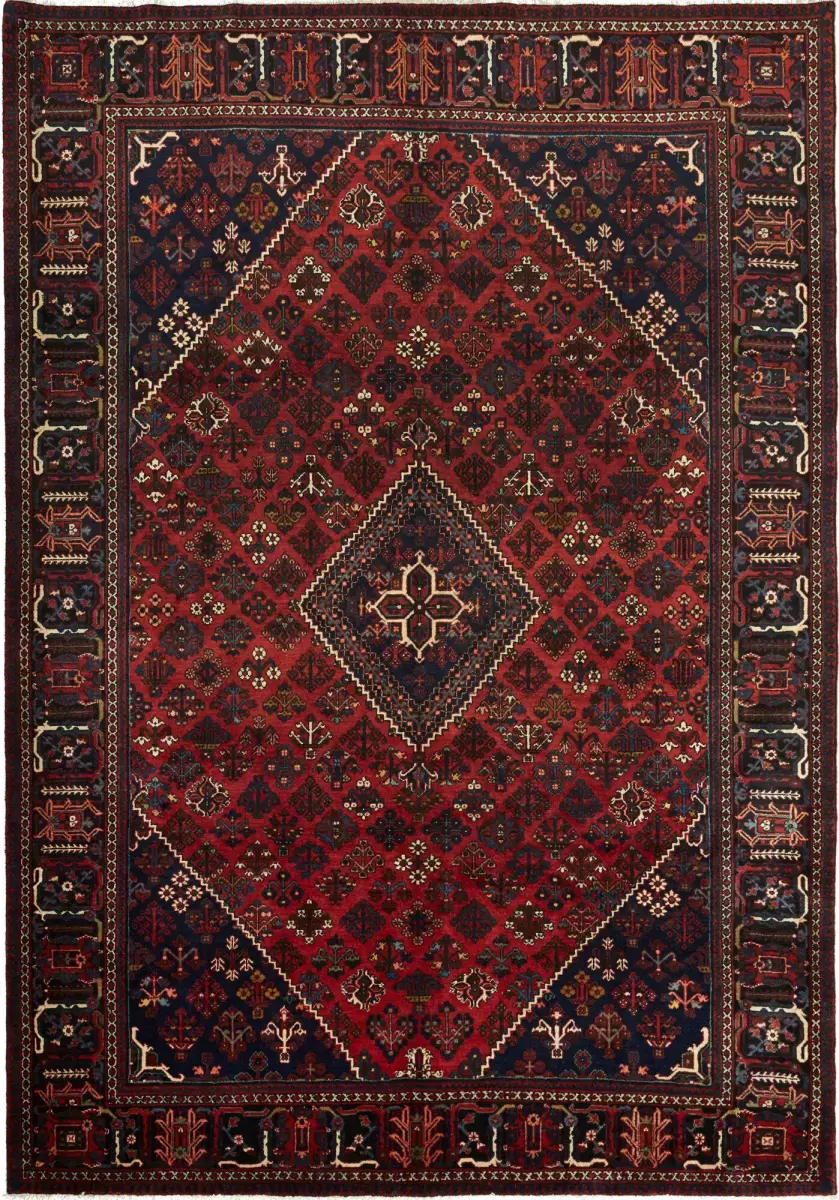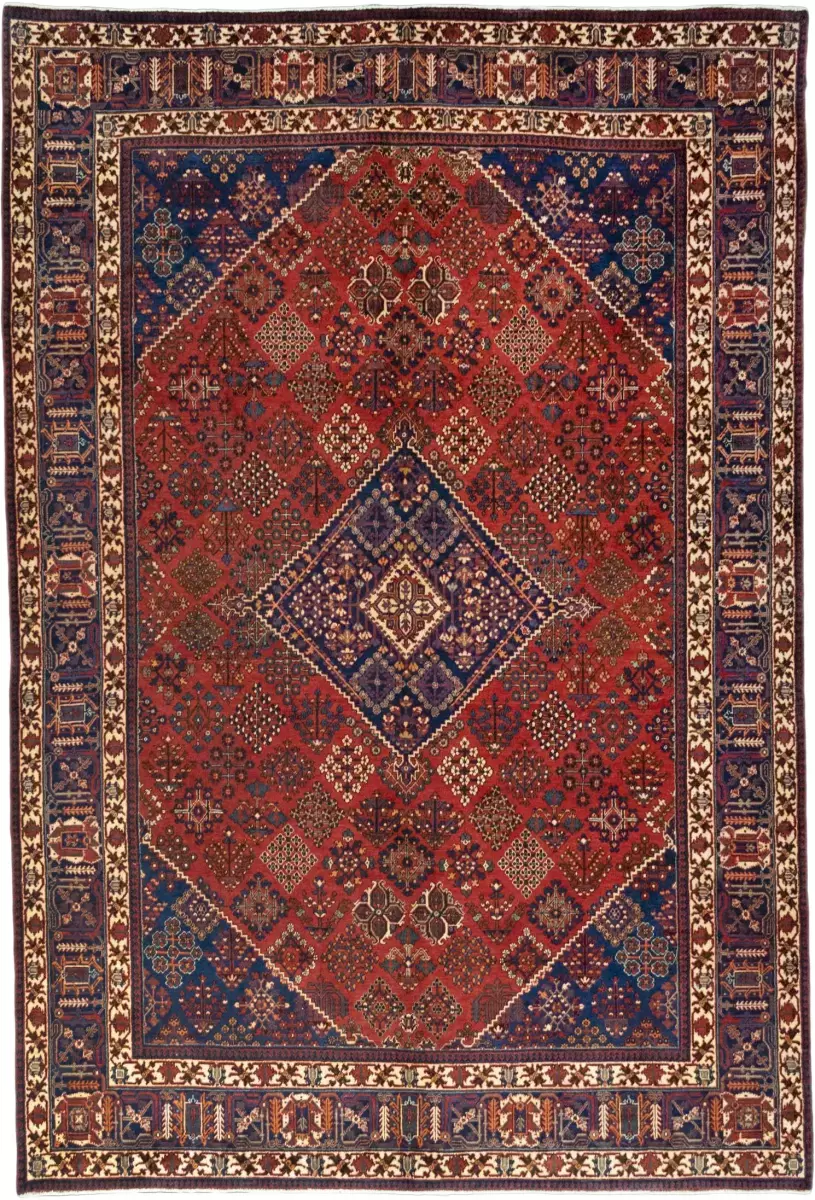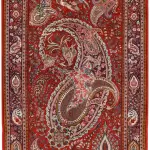Introducing the Joshaghan carpet and its features
Iranian carpet is of special importance in the history of carpet weaving as a work of art as well as a commercial product. The terms "Oriental carpet" and "Iranian carpet" have a synonymous meaning for some, and the historical and artistic importance of the Iranian tradition has been proven for everyone. The rich design and patterns of Iranian carpets, in the form of beautiful compositions and pleasant colors, have always amazed the viewers. Joshaghan carpet is one of these beautiful and eye-catching Iranian carpets. In this article, we are going to introduce you to the features of Joshaghan carpet.
Joshaghan and its carpet weaving background
Joshaghan is a city with a cool and moderate climate, which is located 60 km from Kashan. This city is located on an important trade route between Kashan and Isfahan. The history of Joshaghan carpet weaving can be divided into two distinct periods. The first period includes the productions of the Safavid era, which researchers offer various theories about their attribution to Joshaghan. The second period includes the productions of the Qajar period and after that there is no doubt about the attribution of the samples. In the first period, luxurious carpets were prepared based on pre-prepared designs and with expensive materials in royal workshops. The characteristics of the carpets of this era are the variety of designs and colors, the influence of designs from areas such as Herat, and the texture of large-sized carpets. From the end of this period, the process of changing the design style begins. In the second period, carpet weaves with cheaper materials, mental woven designs with less variety than the first period, carpets with less density and smaller dimensions are popular. From this period, a special style of Joshaghan carpet emerged and it is bought and sold under the brand name of this city.
Joshaghan carpet in the Safavid period
There is no reliable reliable information about the state of Joshaghan carpet weaving before the Safavid era, however, some researchers believe in the history of silk carpet weaving before the Safavid era. In addition, some people believe that the weaving of the luxurious carpets of the Safavid era is not possible without a history of weaving in this region. In the Safavid era, there is evidence of the existence of Joshaghan carpet weaving. This evidence is related to the gifts of Shah Tahmasab I to Indian and Ottoman kings. In 950 A.H. Shah Tahmasab presents two talabaf velvet carpets and three pairs of 12-gauge Joshaghani carpets to Humayun, the king of India who took refuge in Iran. Sultan Bayezid, the refugee son of Sultan Suleiman Osmani, also died in 961 A.H. From Shah Tahmasab, he receives woven gold carpets of Kerman and Joshaghan as a gift. In addition, according to the writings of Abulfazl Allami, the biographer of Akbar Shah, the Mughal emperor, at the end of this century, carpets were imported to India from Joshaghan, Khuzestan, Kerman and Sabzevar. Although there is no sample of the carpets, it is easy to understand the luxury of these carpets. The next carpet example is related to the reign of Shah Abbas I, according to the documents, carpet weaving workshops were established in the cities and villages of Iran during this king's time. During this period, when Isfahan was the capital of the Safavids, government carpet weaving workshops were established in Kashan, Joshaghan, Kerman and Herat. One of the reasons for the establishment of carpet weaving workshops in Joshaghan is the seasonal climate of the region, which is suitable for setting up summer workshops, and the quality of the wool of native lambs in Joshaghan. Although the prevalence of carpet weaving in Joshaghan during the Safavid period is confirmed by many experts, there is no consensus regarding the location of carpet weaving that some sources attribute to Joshaghan. Polish carpets and potted carpets are of this type.
Potted carpets with sparkling texture
Guldani is a name for a large group of different carpet designs that were woven during a certain period. These designs include "garden carpets, carpets with central designs, multi-striped designs, directional designs, artichoke leaf designs (this design is also known as herati or fish), slimy, tree and bush designs generally include cedar motifs and band designs. . Among these motifs, "Bandi" pattern carpets are woven more than others in Joshaghan. One of the characteristics of this group is the long length of the carpet compared to its width (usually the length is three times the width) and the narrow border of this group of carpets. The use of plant motifs such as Shah Abbasi, the movement of flower stems that create rhombus-shaped spaces, vases or vases from which the stems grow, and the number of three rows of borders are among their other characteristics.

Carpets known as Polish
Carpets with the name "Polish" or "Polonzi" are other woven carpets that belong to the Safavid period, and the place of their weaving is attributed to Joshaghan, Isfahan and Kashan. In fact, Polish and vase rugs use the same weaving technique. The carpets of this collection are distinguished from other carpets of this period in terms of the use of gold and silver and the wide range of designs and patterns, as well as the use of soft colors.
The reason for naming Polish carpets
From there, the title of Polones or Polish was placed on these Joshaghan or Kashan carpets, and some of these carpets were exhibited at the Paris International Exhibition in 1878. In the identification card of these carpets, the place of their weaving was wrongly written as Poland, and from that date this group of carpets became known as Polish or Polonzi. But originally, Polish carpets were a type of hand-woven Iranian rugs that were woven in Kashan and Joshaghan to the European (Polish) company's order and according to the design and taste of Europeans. The design, pattern and coloring of these carpets look slightly different from authentic Iranian carpets because they are woven according to European tastes. Many experts believe that these carpets were woven and produced only in the workshops of the royal court of Shah Abbas, while according to the evidence found in many areas of Iran where carpet weaving was carried out, Zarbaft silk carpets were woven and existed in open markets. Even ordinary people could buy it.
Technical features of Polish carpets
Asymmetric knots are used in the texture of this group of carpets, which are created with silk pile on cotton and sometimes wool yarns. Cotton wefts in some carpets are dyed and are in a color other than white; The reason for this can be more matching with the carpet part of some carpets in this collection.
Color in Polish carpets
Colored fibers used in Polish carpets usually have a lot of color variation, and in some examples, the intensity of color variation has been reduced. In some examples of the carpets of this collection, whose color has remained in the original state, it shows that the original Polish or Polonaise carpets had a lot of shine and shine at the beginning. Some of these carpets are purple or ruby, but in most carpets, new colors have been used, which were obtained due to the advancement of the dyeing technique of the Safavid era. Almost in most examples of Polish carpets, various types of yellow colors are used, especially light maroon and orange, which can be seen next to green. The golden thread is actually a wide or thin thread of silver plating that is wrapped around the silk thread and then tied to the carpet weft. Many of these Zarbaft carpets have suffered a lot of damage over time. Their fluff has disappeared and the colors have faded and the silver has turned black and the gold water on it has been removed. But if we consider the first of them, it must be said that these carpets have no competitors in the world.
Design in Polish carpets
Most of these carpets have unique patterns; Paired carpets, both of which have the same pattern, are less common among Polish carpets; Despite this variety, all these carpets are basically similar to each other in terms of texture, color combination, and floral and plant patterns based on geometrical principles. In general, Polish carpets are simpler compared to authentic Iranian carpets in terms of variety of colors and elaborate designs because they are woven to the order and taste of Europeans.
Is gold really used in the weaving of Polish carpets?
Although Polish carpets are often known as gold-weave, which means the use of gold fibers in its texture, gold has not been seen in any of the carpets that have been carefully examined so far, and what has been obtained is in fact completely gold-plated silver threads. have been. Preparing this metal wire is considered a special profession and art. A thin flat strip of pure silver is wrapped around a thin thread of white silk, and if yellow or plated silver is used, the silk thread used is also chosen to be bright yellow, so that if the layer of the top metal is broken or torn off. Or it will slip from its place and the color that can be seen on the side of the river will be yellow.
Technical features of Joshaghan carpet
- The type of knotting and knotting in Joshaghan, like its neighboring weaving centers such as Kashan and Isfahan, is the Persian or asymmetrical knotting.
- Twin knots are also sometimes seen in Joshaghan carpet weaving, however, Joshaghan products have owed their quality to the local hand-spun wools of this region.
- In fact, one of the characteristics of Joshaghan carpets, especially in recent years, is the use of high-quality hand-spun wool from the same region with a brilliant appearance, density between 2000 and 5000 knots per decimeter square, which is equal to the index of 28 to 45, medium to long piles.
- Regarding fiber dyeing, it should be said that 12 natural colors are made in this area by local dyers and are used in the texture of Bosghan carpets. Also, the use of synthetic and aniline dyes in boiling is not common.
- The material of the warp in Bosghan carpets is generally made of cotton and sometimes may be made of wool. Wool is used for the weft of carpets, and sometimes the wefts are dyed red, brown, or red-brown, but self-dyed wool is often used.
Designs and patterns in Joshaghan carpet
The three designs of recent decades are Joshaghan, Jungle or Joshaghani, Kashmiri and Khanabandi rugs. The jungle design is easier to weave than the cashmere design and that is why the jungle design is more popular. The motifs in all three designs are the same and non-rotating, and the different composition of these motifs is what distinguishes the designs from each other. Other than that, the margin is the same in all three designs. The only factor in the variety of borders is the size of the carpets. Large rugs, rugs, back and side rugs each have their own borders. As an example of the fringe that is woven in large carpets, it is known as the fringe of Allah. This border is used for all three designs that are knitted in the large size.
The design known as "jungle" or "Joshaghani" in Joshaghan carpet
Jungle or Joshaghani is the most famous carpet design in Joshaghan. This design consists of a regular network of rhombuses, each rhombus is independent and without connection with other rhombuses in the text. This design is woven in the form of lace and fringe or without it. The lines around the bergamot and lach are jagged and known as the stairs. If none of the laces and fringes are woven into the carpet, the design is called a forest pattern. In cases where lakhs come without bergamot, a central role called salimi or chaharferangi is used instead of bergamot.
The color in the glowing carpet
Almost all designs of sparkling rugs use a few of the same colors for texture. These colors mainly include dark blue, pink and white, which are used for the background, border, laces and bergamot, and other colors include different shades of blue, green, yellow and brown. Cream dyeing of carpets is done by natural and rarely chemical substances.
Buying and selling carpets in Joshaghan
In Joshaghan, carpets are bought in two ways. In the method of wage weaving, carpet weaving is done based on the order. The customer prepares the materials and the cost of weaving and such works is his responsibility, and finally the finished carpet belongs to the customer and the wages are delivered to the weaver. In another method, the weaver prepares the material and sells the finished rug to the buyer.
Final word
Due to its location on the road between Kashan and Isfahan, the city of Joshaghan has been considered one of the important centers of carpet weaving in Iran since the distant past, especially during the Safavid period. During the Safavid era, this city was famous for the weaving of carpets with vase designs, as well as the famous Polish zarbaft carpets. Currently, the "jungle" design is one of the most important types of handwoven carpets in Joshaghan. The fame of Joshaghan carpet is due to the use of fine and high-quality local wool, which gives high quality and beauty to the final product.
You can inquire about Buying Handwoven Carpets , Buying Handwoven Kilim and Mats , and Buying Handwoven Pictorial Rug Tableaus online from the Hoveida Carpet Store and register all your orders and Wherever you are in the world, deliver it to the desired address in less than 4 working days.
If you are interested in reading other articles in the field of Handwoven carpets or Handwoven Pictorial Rug Tableaus , please refer to Hoveida Carpet Commercial .
Leave a comment
Your email address will not be published. Required fields are marked *












